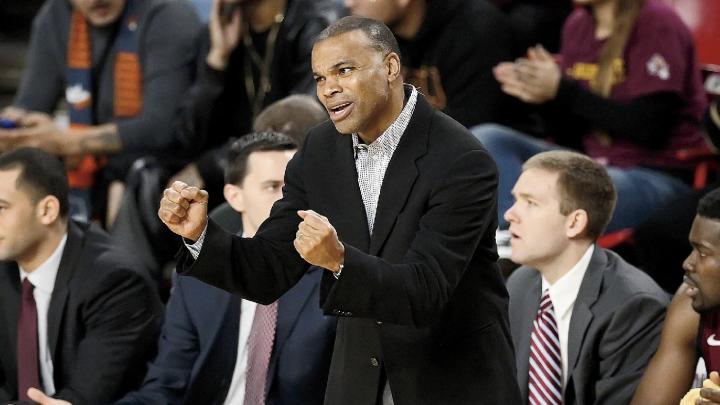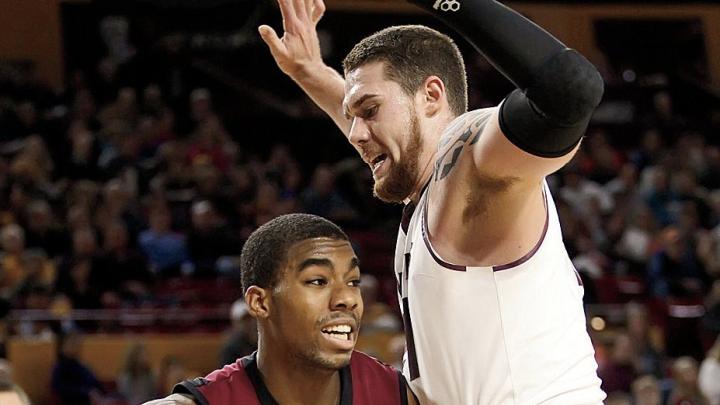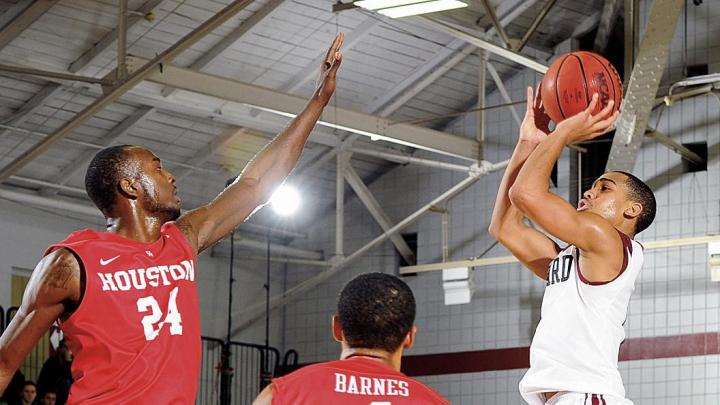On a Sunday morning in late January 2009, the Harvard men’s basketball team gathered at Lavietes Pavilion, anxious about what awaited them. After toppling Boston College earlier that month—the program’s first victory over a ranked opponent—the Crimson had lost the previous evening in overtime to a frail Dartmouth squad that had arrived in Cambridge with a 2-13 record. “We’re better than we played tonight,” lamented head coach Tommy Amaker, who added a warning for his players: “It will inspire us to have a good week in practice.”
Sure enough, in what one former team affiliate later characterized as the “toughest practice” of the year, the coach had his players—who had given up myriad easy baskets against Dartmouth—run extensively so they’d remember, the man recalled, the kind of painful feeling they should have after giving up uncontested layups.
But Amaker complemented this punishment with what the onlooker called “his best motivational speech of the season.” He reiterated his vision of growing Harvard’s program, which had never won an Ivy League title; he also told his team that he had gone so far as to price out its first conference championship banner.
Since finishing that season 14-14, the Harvard men have reeled off five straight 20-win seasons and earned their first four championship banners.
This year, however, the coach and his players are discovering that the fifth banner will be the most difficult. After beginning the season in the Associated Press Top 25, the first time an Ivy League squad had received such recognition since 1974, Harvard suffered several disappointing losses in non-conference play and an early Ivy setback against Dartmouth. Thus, as Ivy play began, Amaker and his squad faced the challenges of finding, quickly, the synergy lacking during much of their pre-Ivy schedule—and of contending with a league that has more competitive, confident players than any Amaker-led Crimson squad has encountered.
High Expectations—and Deflation
Talk of the 2014-2015 campaign began before last season had concluded, and at first it had a contentious tinge. In a press conference at the onset of the 2014 NCAA tournament, Amaker addressed questions not about Cincinnati, Harvard’s first-round opponent, but rumors that he was leaving to become Boston College’s coach. “I’ll only comment on the job that I have,” he said, “and I’m very proud to have the one representing Harvard.”
Yet after the Crimson nearly knocked off Michigan State in the Round of 32 and Amaker then announced in late March that he was staying in Cambridge (a reworked contract reportedly sweetened the deal), discussion of the 2014-2015 campaign became positively ebullient. Despite the graduation of stars Kyle Casey ’13 (’14), Brandyn Curry ’13 (’14), and Laurent Rivard ’14, analysts raved about the returning core of Wesley Saunders ’15, the reigning Ivy League Player of the Year; point guard Siyani Chambers ’16, whom ESPN ranked the thirty-fourth best player in the nation in November; and a front court that boasted all-Ivy forward Steve Moundou-Missi ’15 and Kenyatta Smith ’15, a six-foot-eight center who had anchored the Crimson in the post during the second half of the 2012-2013 season, including its victory over New Mexico during the NCAA tournament.
It was therefore unsurprising that Harvard was a unanimous pick to win the Ivy League in the pre-season media poll. Shortly after the Associated Press anointment, Mike James ’06, The Crimson’s former basketball beat writer, encapsulated popular sentiment by posting on his popular Twitter feed, @Ivybball: “Take a bow, Mr. Amaker.”
It took but two games for the plaudits to dissipate. Following a season-opening victory over MIT, a Division III opponent, the Crimson lost to Holy Cross 58-57, causing the squad to plummet from the national rankings and raising multiple concerns about its prospects.
One was turnovers. Harvard had 24 giveaways against the Crusaders; Chambers, whom Amaker has repeatedly labeled Harvard’s “most important player,” had nine.
Making matters worse, the offense depended too heavily on Saunders. The senior guard accounted for 24 of Harvard’s 57 points, and Amaker’s offense, which prizes frequent passing and extensive movement off the ball, often stagnated when Saunders operated in isolation. Still, the team had a chance to win when Saunders held the ball with the clock winding down and Harvard behind by one. When his shot rimmed out, the Crimson learned the hard way that, talented as Saunders is, he cannot carry them.
Apart from plays and schemes, the biggest problem was that neither Saunders nor his teammates exhibited enough energy and passion. “I think that they [Holy Cross] came out with a level of intensity that was higher than ours and we never matched it,” Saunders said after the game.
Regroup and Respond...
Following the loss to Holy Cross, the basketball program tweeted a message, previewing its matchup with Florida Atlantic, accompanied by the hashtag “#RegroupandRespond.” The Crimson did exactly that, exacting revenge on the Owls (a squad that had snake-bitten them the previous year in Boca Raton) with a 22-point blowout win at Lavietes Pavilion. The victory ignited a six-game winning streak during which Harvard dispatched five of its opponents by 12 or more points.
The most impressive game in this stretch was a 75-73 victory over the University of Massachusetts—the “best team” Harvard had faced, according to Amaker. Played the Saturday after Thanksgiving, the game attracted a decidedly pro-UMass crowd to Harvard’s gym. Despite enduring UMass chants throughout the game, the Crimson secured a come-from-behind victory: Saunders hit a game-winning shot with just under a minute left, the “perfect ending,” he said, to a game like that.
The team’s performance during the streak suggested that Harvard had corrected many of its miscues from the Holy Cross debacle. The Crimson averaged fewer than 11 turnovers per game; Chambers had only 15—less than three per game. Shooting guard Corbin Miller ’15 (’17), who had missed the last two seasons on a Mormon mission, lessened the offensive burden on Saunders by hitting three or more three-pointers on three occasions. Most impressively, Harvard pulled out a double-overtime victory against Vermont in Burlington, leading Amaker to laud his players for their “concentration,” “composure,” and “confidence.”
The Crimson again looked formidable.
…Only to Revert
Then the wheels came off. In late December, after a two-week hiatus for exams, the squad traveled to Charlottesville to face the University of Virginia, then the country’s fifth-ranked team. The Cavaliers embarrassed the Crimson: Harvard trailed 39-8 and sank just one basket before halftime, Chambers and Saunders did not hit a single field goal the entire game, and the 49-point margin of defeat was the worst since Amaker’s first game at Harvard (when the Crimson fell to Stanford by 55 points). Afterward, the coach said, “You never expect your team to come out like that.”
The squad’s struggles continued after Christmas when it crossed the country to face another prominent opponent, Arizona State. The Crimson trailed by only four points at halftime, largely because Saunders had tallied 13 points on an array of jumpers, driving layups, and a step-back three. Unfortunately, he scored just two points the rest of the way, and the Crimson lost 56-46, absorbing a reminder of the dangers of relying so heavily on one player.
Harvard closed out its western trip, and 2014, with a 72-59 win over Grand Canyon University, but the listless effort against Virginia and the setback against Arizona State meant that the matchup with the Antelopes, who are in their second year in Division I athletics, was what Saunders called a “must win.”
The victory was cause for relief, not celebration, and as 2015 began, the Crimson continued to perform inconsistently. On a positive note, they thrashed Saint Rose, a Division II opponent, by 46 points; earned an 11-point conference victory against Dartmouth in Hanover; and narrowly escaped Bryant with a nine-point win. But they suffered an overtime loss to Boston College, their first setback against the Eagles in seven tries, primarily because they dug themselves a 25-10 hole less than 12 minutes into the contest. As Amaker said afterward, “I thought we deserved the second half, and I thought they deserved the game.”
But the game encapsulating the 2014-2015 season to date was Dartmouth’s visit to Cambridge on January 24. After a back-and-forth first half, Harvard began the second half on a 15-4 run to take a 43-29 lead. It appeared the Crimson was on its way to dominating the Big Green, as in their previous 11 meetings. That’s what made the next 10 minutes of play so shocking: Dartmouth reeled off 26 of the next 28 points to take a double-digit lead—and won, 70-61, when point guard Alex Mitola made 10 consecutive free throws down the stretch.
The loss was significant not just because it dropped Harvard to 1-1 in league play, but because it suggested that the team had not, in fact, rectified the weaknesses revealed in the Holy Cross game. The team had 18 turnovers, six by Saunders. That he co-led the team in scoring with 13 points despite his many miscues underscored the squad’s dangerous dependence on him. Most alarmingly, his post-game lamentation about the team’s lack of fight echoed his comments after the early-season loss to Holy Cross: “They definitely wanted to win way more than us.”
Bouncing Back
But then the Crimson responded emphatically on the road the following weekend, defeating Princeton 75-72 on Friday and throttling Pennsylvania 63-38 on Saturday. Against the Tigers, five Harvard players scored 10 or more points, and Saunders, who had 14 points and eight assists, scored and distributed. In Philadelphia, the team won with defense: in the first half, the Crimson held the Quakers to just six field goals in 20 attempts (a meager 30 percent rate), en route to a 36-15 lead. Had Amaker not begun emptying his bench with roughly 10 minutes left in the contest, based on what was then a 30-point advantage, Harvard’s margin of victory could have ballooned further. Together the victories suggested that the Crimson had sharpened their focus. The question, as had been the case all year, remained whether they could sustain it.
Although it’s tempting to malign the Crimson for inconsistency, it is not entirely justified. No matter how much talent was returning, it was excessively optimistic for the media to herald (and rank in the Top 25) a program that had graduated three players who together scored more than 3,400 career points. As Matt Brown ’14 (’15), the lone remaining player from Harvard’s first Ivy League championship squad, recently observed, “Last year all those guys graduating was like a generation leaving, so this is a new time for Harvard basketball.”
What’s more, the pushback by other Ivy teams indicates that the conference as a whole is improving. Entering the second weekend of back-to-back conference games, four teams had records of .500 or better. The biggest threat to the Crimson is Yale, a squad that defeated Harvard last year in Cambridge, reached the final of last year’s CollegeInsider.com Postseason Tournament, and upended defending national champion UConn earlier this year. As Dartmouth coach Paul Cormier has observed, the increased Ivy parity means “Everybody [has] to come ready to play every night, because if you don’t, you’re going to get whooped.”
Given a Crimson squad afflicted by so much turnover, so many turnovers, and sharper opposition, what will a fifth championship banner require? According to Amaker, this squad must turn inward and, in particular, “rely on each other” in a way that past Harvard squads did not. Those teams thrived in part through excellent synergy and had more than one player—such as Keith Wright ’12, Kyle Casey, and Laurent Rivard—who could impose his will on a game. On this year’s squad, only Saunders can do that consistently; and as the losses to Holy Cross and Arizona State showed, depending on him is not a championship-caliber strategy.
Thus, if the team wins the conference, it will not be because of Saunders or Chambers or even Amaker, but instead because of the collective ability of the 18 players and their coaches to bind together offensively, defensively, and emotionally.
Simply put, the price of a fifth banner is teamwork.










